Frédéric LEFRANÇOIS
Université des Antilles
Abstract
This paper aims to highlight the articulation of skin memory with trans-Caribbean aesthetics by exploring the diasporic works of female diasporic artists born in the West Indies who emigrated to the United States. We intend to show how these contemporary female artists rewrite the codification and reception of the skin-related memory by connecting their artwork to a genealogy of traumas and healing practices that call for the empowerment of the Caribbean skin ego.
Keywords: Caribbean art, body politics, memory, performance, skin ego.
Decolonizing Trans-American Skin Memory
Where are your monuments, your battles, martyrs? Where is your tribal memory? Sirs, in that grey vault. The sea. The sea has locked them up. The sea is History.
Derek Walcott
A people without history
Is not redeemed from time, for history is a pattern
Of timeless moments
S. Eliot
My skin had becomea palimpsest of fleeting sensations, and each layer bore the imprint of who I was.
Paul Auster
Introduction
One option stands out among all the navigation paths on the ocean of contemporary visual arts from Middle America: the idea that any form of art created in this mangrovy[1] – the median, fractal hub of cultural circulation known as the Great Caribbean – is prone to storing, transferring and revisiting the wounds of a fragmented colonial history in another sphere of experience for the sake of birthing beauty. If this extended metaphor echoes Walcott’s poetic admiration for marine pregnancy, it also reminds us of T.S. Eliot’s warning about the risks of delivering stillborn art when indulging in historic amnesia. And, last, but not least, it certainly hints at the sedimentary, haptic, capacity of Caribbean aesthetics.
For the visual artists endowed with a certain level of historical sensitivity, being born in the Caribbean can represent a challenge. Unknowing the exact location of their multiple roots, these poly-centred subjects are constantly confronted with the temptation of giving in to hybrid indeterminacy. Loss of history, memory, and identity always lurks around the corner. Wandering about the edges of their jigsaw worlds, Mesoamerican practitioners need to re-connect to the common thread of history, to the times when the Caribbean was one, before the first Spanish flag transfixed Guanahani. Yet, for want of guidance on the map of Pan-Caribbean historical identities, they may soon find themselves amazed, lost in a maze of scattered mnemonic fragments. How can art help reconnect fragments of memory that have been dispersed, written over or partially erased?
Artistic practice and trans-generational dermic memory
In “The Antilles: Fragments of Epic Memory”, Derek Walcott intimates an archaeological approach to better circumscribe the issue of transgenerational memory recomposition:
Break a vase, and the love that reassembles the fragments is stronger than that love which took its symmetry for granted when it was whole. The glue that fits the pieces is the sealing of its original shape. It is such a love that reassembles our African and Asiatic fragments, the cracked heirlooms whose restoration shows its white scars[2].
Walcott concludes this powerfully metaphoric paragraph with a phrase that summons the sense of touch. The hand which has dug up the buried fragments of an Amerindian vase has yet to recollect and reconnect each of these memory bits before a new vessel may deserve more attention than the original one. The diasporic drive may veer from the desire to reproduce an almost intact copy of the extant artifact. In truth, gluing these parts together requires patience, understanding, love, and a good measure of haptic memory to re-perform the “sealing of its original shape”. Hence the power of the “white scars”. These are not the words of a critic who would “define a work of art by following the needs of his own individual nature and the particular objectives of his research”[3], but the markings of a master poet who devoted a significant part of his time to watercolor painting and a passion of ceramics. Since the vase is assimilated to a haptic memory holder, its outer surface can compare with some kind of artistic skin. Its parcels must be mapped out onto a virtual model so as to constitute a new original. Stitching these fragments together is the artist’s ordeal, inasmuch as Walcott emphasizes that:
This gathering of broken pieces is the care and pain of the Antilles, and if the pieces are disparate, ill-fitting, they contain more pain than their original sculpture, those icons and sacred vessels taken for granted in their ancestral places. Antillean art is this restoration of our shattered histories, our shards of vocabulary, our archipelago becoming a synonym for pieces broken off from the original continent[4].
The above statement converges with Focillon’s idea that “the creator of a work of art regards his work (…) from a standpoint very different from that taken by the critic, and should he chance to use the same language in speaking of it, he does so in quite another sense”[5]. The artist’s vision is necessarily more holistic than the analyst’s. What Walcott intuitively pictures as an incomplete and difficult puzzle echoes Glissant’s aesthetics of the chaos-monde: “The aesthetics of the chaos-monde (…) embraces aIl the elements and forms of expression of this totality within us; it is totality’s act and its fluidity, totality’s reflection and agent in motion[6]”.
Like some kind of plastic surgeon aspiring to remodel the face of Caribbean skin history, the artist has to write and rewrite a story without text. The fragments laid bare on the skin of memory can relate to each other when the plastician fills in the gaps of spotty knowledge gathered from past excavations. Pasting, stitching, patch-working, and remodeling are acts of re-membering and remembrance that require a medium and a binder. In this case, the binding agent that Walcott identifies as ‘love’ finds equivalents in Glissant’s phraseology with such terms as ‘rhizome’ or ‘Relation’:
This is not passive participation. Passivity plays no part in Relation. Every time an individual or community attempts to define its place in it, even if this place is disputed, it helps blow the usual way of thinking off course, driving out the now weary rules of former classicisms, making new “follow-throughs” to chaos-monde possible[7].
Commenting on this theoretical framework, Isabel Hoving explains that “Glissant’s early evocations of relationality picture the cross-cultural world as a rhizomatic network of relations, in which the identity of every particular space, landscape, nation or individual is shaped by its cross-cultural and transnational relations to others, and therefore always in the process of transformation”[8]. Art, in its dealing with diachronic time, contributes to the ongoing evolution of reality perception. Its survival owes much to the preservation of transgenerational transmission patterns and to the archival of the unconscious, sometimes hidden writing processes.
Likewise, rhizomic skin memory aggregates infra-topologic, haptic, transgenerational memories, and testify to the reach of Edward Kamau Brathwaite’s catchphrase: “The unity is sub-marine[9]”. When, for instance, sculptors like Laurent Valère and Jason deCayres Taylor create immersed, yet tangible submarine artworks, they expect people to have a tactile connection with them and cherish a memory of that contact.
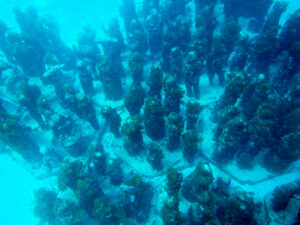
Fig. 1 : Jason de Caires Taylor, The Silent Evolution, Cancún Underwater Museum, 2010. Source: https://en.wikipedia.org/wiki/Jason_deCaires_Taylor#cite_note-NatGeo1-2 (Creative Commons license).
Statues are meant for touching. They foster a tactile memory which comes about as the result of palimpsestic sedimentation. Laurent Valère also explores the mythological connection by way of diasporic cross-cultural exchange. His most well-known monumental sculptures located on the coastal seabed of Saint-Pierre, in Martinique, are entitled Manman Dlo (in English: “Mermaid” or, literally, “Water Mother”) and Yemaya, in reference to the Cuban goddess of Yoruba origin.
Haptic memory, however, is quite short-termed. It needs regular direct and cross-sensorial reactivation to be stored in medium and long-term memory. The Caribbean artist is, therefore, entitled to transmit a legacy of personal and ancestral connections with what his predecessors bequeathed him. Rock art, in this respect, provides an invaluable source of inspiration for those who wish to link their local histories to global, diasporic kinships[10].
Diasporic skin memory
Accordingly, artistic commitment to this task may be yoked with the mission of regaining memory, with the ideal of mapping out the crossways of diasporic connectedness[11]. Hence the importance of defragmentation and recollection. Gathering up all these fragments may look like a titanic challenge, but it is a necessary ambition. When poets do serve it, they hearken back to memories of the past and reconnect with their ancestor’s roots by being nudged onto aural routes. In contrast, visual and performance artists have a harder time with such channels. Their message may well sink into oblivion if uncoupled with verbal or kinaesthetic reminiscence. Without the support of writing, speaking, or rehearsing, the chain of visual memories weakens or disbands over time. That is why it falls within the ambit of interdisciplinary, transnational poetics to keep it alive, and working.
Pan-Caribbean art, in this respect, would encompass diverse creations from the insular Caribbean and the coastal territories bordering the Caribbean Basin. These nations share a common history shaped by multifarious waves of migration, slavery, European colonization, creolization, and globalization[12]. Not only do these cultural areas share “share the legacies of European colonialism, the transatlantic slave trade and forced migration”[13], but they also relate to each other through a derivative legacy of colonialism: relocation[14]. For major thinkers like Wilson Harris and Édouard Glissant, the ability to translate the diffracted self into alter-colonial spaces represents a determining condition of artistic creation. Such an agenda can be fulfilled if the subject has the ability to withdraw himself or herself from the colonial matrix of power and relocate in alternative spaces, a process that art theoretician René Louise calls ‘conceptual marooning’[15].
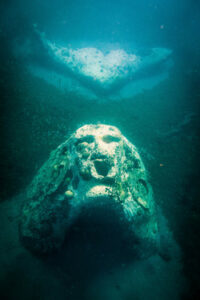
Fig. 2: Laurent Valère, Manman Dlo, Saint-Pierre, Martinique, 2004. Underwater sculpture, cement. Source: https://www.laurentvalereartstudio – Reuse permission given by the artist.
Recreating the self is also an opportunity for inventive relocation within what Homi Bhabha terms the ‘third space of enunciation”. Artists and writers are, therefore, primarily concerned by the issue of relocating their center (s) amid a constellation of mnemonic/identity fragments. Concurringly, conjuring up new temporalities makes it also possible for art practitioners and theoreticians to melt cultural paradigms and praxis, a secondary process which gains cohesive force thanks to the “hybrid and multidisciplinary fire that today’s researcher directs towards his elusive subject”. Given their liability to fertilize and complete each other, art and history have parallel, free destinies since “there is nothing inside art itself, disconnected from history, which compels it to go in one direction or another”[16]. What part of the self might be found abroad, in another distant territory or timeframe can ideally be reclaimed by dint of decolonial disconnection and pluriversal reconnection[17]. Such aesthetics calls into question the necessity of posing the conditions of balance in a kaleidoscopic environment.
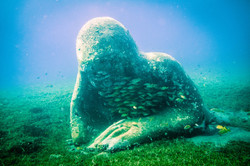
Fig. 3: Laurent Valère, Yemaya, Saint-Pierre, Martinique, 2004. Underwater sculpture, cement. Source: https://www.laurentvalereartstudio – Reuse permission given by the artist.
Though being contingent on the conjunction of many centrifugal forces, art contributed resulted in communal aesthetics expressing some sense of unity in spite of the physical territories between the territories. If one considers the peoples of the Sixth Continent as scattered groups of a large, hybrid, diasporic family, then their history should be apprehended in a similarly inclusive and aggregative way. This vision of the Caribbean, as a meta-archipelago where history repeats itself in variegated environments, is not pure utopia nor an idyllic nest for freewheeling metaphors. Once transposed in the field of the visual arts, it gains the consistency of tangible reality; it becomes reality, like the skin attached to one’s body.
Arguably, this type of issue can both raise interest in cross-disciplinary studies on the cultures of the Caribbean or stir a long-nurtured need for confrontation with the legacies of diasporic connectedness in a trans-colonial context. But it can also target the question of agency considered from a practitioner’s point of view. Antonio Benitez-Rojo sustains that areas “we might see as inhabited by desire, sexuality, power, nationalism, violence, knowledge, or culture”[18] where the subaltern other often finds resistant spaces of expression, are as legitimate as those elicited by the grand narrative of official history. Retelling history from the ‘vanquished’ subject’s point of view equates with filling the other, empty, half of the bottle which deserves as much attention as the filled one. In fact, both are full of fluids, though of different respective natures. One is full of liquid and the other is full of air. De-linking from the colonial agenda does not necessarily mean that one rejects everything that was created during the colonial era. The pervasiveness of libidinal motifs recorded in linguistic structures and popular mentalities still questions the ability of art to perform the actual de-linking from the colonial matrix of power.
At the core of this protracted debate stands the graven image of colonial memory which decolonial aesthetics address with the respect to the ‘de-linking’ agenda: can art be a memory holder? And if so, could human skin be a palimpsest onto which such history would be transferred, encoded, and rewritten?
The Caribbean artist’s skin: a memory holder
Caribbean diasporic art frequently highlights the re-appropriation of traumatic history encoded in collective memory. History may indeed be seen as the archive that stimulates the visual aesthetics is no small responsibility. Combining this choice with decolonial body politics, diverse practitioners have set peculiar standards for encoding and decoding the meaning of their creations. Consequently, these works may not always be readily understandable to those who have not been initiated, introduced to the codes, or received a special courtesy from their authors. But apart from such general considerations, there is another idiosyncrasy of Caribbean visual arts which deserves special attention: its embedding of history within the layers of dermic memory.
Working with human or animal skin invokes problems pertaining to the field of aesthetics and poetics. The calling of creation is soon followed by the traditional challenge of poiesis: finding an original articulation between the materiality of content and the tangibility of form. From one generation to another, this issue has been handed down and tackled in multiple ways by practitioners of different fields. When dealing with the materiality of content, however, the traditional issues of poiesis arises: the idea of a conceptual form has to materialize into the production of tangible work. In that respect, the artist’s mission consists in “bringing something from concealment into the full light and radiation of a created work” (Whitehead, 2003). From that standpoint, the creative urge does not necessarily translate into the epiphany of new aesthetics, especially when its medium and its topic coalesce into an intimate, seemingly familiar surface, like the human skin.
Plasticians like Janine Antoni and Olivia McGilchrist occupy an insecure and ambiguous position in the field of Caribbean Art. Being of white creole descent, both women have investigated the importance of the skin in collective memory. In 2000, Antoni produced Saddle, an artwork combining sculpture, performance, and installation art made with rawhide. Its description on the artist’s website mentions that:
Saddle is a full raw cowhide draped over a mold of Antoni’s body. When the material hardened, the mold was removed. Like a ghost, the cowhide holds the memory of the artist’s body. When confronted with the object one feels the absence of both the artist and the cow.[19]
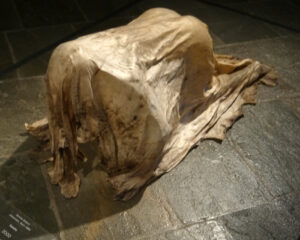
Fig. 4: Janine Antoni, Saddle, full rawhide , 27x32x79 inches (68.58 x 81.29 x 200.66 cm) © Janine Antoni, courtesy of the artist and Luhring Augustine, New York. Photograph shared under Creative Commons License by Eden, Janine and Jim, source: https://www.flickr.com/photos/edenpictures/28681015137
The very fact that the artist has chosen to mold her own body in a subaltern position while crouching on all fours, may seem quite destabilizing for critics well-introduced to critical theory. Presumably, her purpose is not to propose a counter-feminist vision of art, but rather to “play with notions of self-portraiture, self-love, and self-inquiry”[20]. In contrast, Olivia McGilchrist has chosen a more moderate approach by giving indirect access to skin-related issues by curating exhibitions welcoming Caribbean artists who deal with this question.
Now, the topic of visibility or invisibility comes at the fore of contemporary issues. It is true that the exhibited artwork benefits from multifarious attention after having made its way through the maze of galleries or institutional venues. Once it has been released for open contemplation, the creation may even give birth to a vast array of aesthetic judgments, that is to say, any type of formal or informal discourse on its form and content. Needless to say that this secondary, appreciative approach is contingent upon the perception of the observer and the circumstances of the encounter with the artist’s production. What the public ultimately perceives as an outcome of the creation process goes now beyond the issue of finding a correspondence relation between art and the world. As a famous artist would have it, “the moral struggle between notions of beauty and the desire for sublimity” (Newman, 1990: 171) is embedded in the artwork. To the learned eye, it may reflect an alternative for inventing new identities and corporalities that can satisfy unto themselves.
When it comes to Caribbean visual arts, one cannot but notice that most practitioners are challenged by the urge to find new poetics. This all falls down to tackling the issue of intentionality while dealing with the materiality of human bodies, and more specifically, with their skins. In fact, the human skin is a thin protective membrane that inaugurates our first social interactions with the outer world. It is also the one that sets us apart from it. The perception and apprehension of the physical environment depend on the subject’s ability to interpret the stimuli received simultaneously from diverse sources. Therefore, no sooner does one begin to differentiate pleasant stimuli from unpleasant ones than the skin develops a memory of its own. As life unfolds, an accumulative story of tactile events itches its way across the grooves and furrows of this multi-layered, fragile, envelope which is the largest organ of the human body. As far back as one can reminisce, our memories of things past have a direct connection with this inaugural haptic experience.
The versatile plastic creations of Cuban artists like Ana Mendieta, Manuel Mendive, and Magdalena Campos-Pons constantly remind us that the skin is a thin, fragile, boundary between the sensitive layers of the body and the external world. But it is also a filtering agent, with its own identity, its own criteria for choosing what it will let in and what it will let out. But if the skin is memory, what kind of memory is it? And what is its capacity to restore the traces of past experiences? If memory is capable of recording facts, events, feelings, or emotions, and associating them with a particular time frame, memories of things past are also bound to disappear. What can reactivate haptic memory? How do viewers react to the solicitation of an artwork when the latter points to deep layers of the collective unconscious pregnant with trans-generational traumas? Does their skin memory reminisce something when the eye of the beholder visualizes brown skins on canvas or on photographs?
Some answers to these questions can be provided by a comparative study of photo-performance artworks created by Ana Mendieta, Manuel Mendive, and Maria Magdalena Campos-Pons. To begin with, Mendieta was sent to live in the USA to escape the turmoil of the Cuban Revolution when she was only twelve years old. She was part of the Peter Pan Operation which led to the deportation of hundreds of children and teenagers to the US in reaction to the socialist regime that had toppled the pro-capitalist, military dictatorship of President Fulgencio Batista. This was a truly traumatic experience for the young Latina woman who was confronted with ordinary racism. But exile and the loss of family connections was the most exacting hardship. Art became her salvation. Mendieta opted for “employing her body as a sculptural surrogate to create three-dimensional impressions on the primeval form[21]”. The transgenerational, trans-generic phasing of memory also transpires through Tree of Life, which evidences the desire to reconnect with nature. The performer’s skin is covered with brown pigment to camouflage her body and fuse it into the texture of tree bark. Her artistic path follows the syncretic regla of Yoruba belief which urges adepts of Santería to welcome all the forces of nature in their lives, as they are manifestations of spiritual guidance. Communion with an element of symbolic centrality in this belief system accounts for the desire to become one with the material roots leading to spiritual routes. But, even more interestingly, this metaphor for rejuvenation of artist culture by tuning to Nature suggests that the focus should be “more the mangrove than the tree”[22].
Speaking about the artistic performances of Cuban Manuel Mendive, one cannot but notice its diasporic connection with the work of Ana Mendieta[23]. Both artists apply overlays of the white medium on the brown skins of their own bodies or on those of participant performers. It is also a matter of symbolic significance: the white color is deeply connected to Yoruba spirituality. Most rites of the Afro-Caribbean diasporic religious system refer to the materiality of a white material medium. Rites of passage calling up the mediation of ancestors include the arcane art of vêvê-drawing, the white attributes of demiurgic deities, hence the desire to honor and pass down such traditions with respect to the transversality of chromatic code.
Remodeling and rewriting skin memory
Rewriting calls on inclusive and creative processes that transcend mere repetition. In the performing arts such as theatre, dance, and performance, the artist’s body is often challenged by its ability to connect with rituals inherited from the past. But the past, and the cognizance of the past, are two distinct things. Where there is some similarity of form, the palimpsestic body creates gaps, cracks, and openings for the inscription of rewritten narratives onto a seemingly familiar scroll, namely, the performer’s skin.
On the aesthetic level, Mendieta’s Siluetas recall Yves Klein’s Anthropometries. However, their respective purposes veer in different ways from the academic tradition. Instead of maintaining a distance between the subject and its artistic representation, Mendieta’s body of performance artwork dwells in symbolic realms pointing to traumatic visions of the past[24]. The blood that is often smeared on the artist’s own body calls for a cure and a reunion with Mother Earth and her Taino ancestry, whereas such mythical/historical considerations are disconnected from Klein’s blue compositions.
Mendieta’s metaphysical relation to Itiba Cahubaba, the bleeding Mother-Earth of Taino cosmogony, coincides with the artist’s visceral connection to her native Cuba. It is worth mentioning that this deity plays a central role in empowering women. Interestingly enough, her influence spans from the Greater Antilles to the northern part of Guadeloupe. Rock art carvings from the Eastern Caribbean sites are scarce, but some were found on one of the river banks of Trois-Rivières. She is represented as a woman delivering a baby in the fluvial waters. Not only does she act benevolently towards mankind each time she presides over birth rituals, but she also guides women towards maturity and helps them to empower their womanhood in a male-dominated environment. Itiba Cahubaba/Yemaya/Mammy Wata is, from that standpoint, a progressive and inclusive archetype.
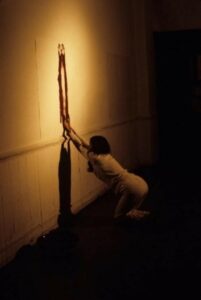
Fig. 5: Ana Mendieta, Siluetas, performance delivered on 4 Aug. 1982. Retrieved from https://library-artstor-org.bu-services.univ-antilles/fr/asset/AFURNACEIG_10310797082 (Creative Commons License authorization for republication).
Likewise, the question of inclusiveness informs Campos-Pons’ When I Am not Here, Estoy Alla series. Flag Color Code Venice 13, subverts traditional visual codes in a quite subtle and inventive dialogue with academism that deserves particular attention with respect to biopolitics and skin agency.
Here again, the female artist’s body is invested with remarkable symbolic power. Echoing Manuel Mendive’s artistic path, Campos-Pons has designed a complementary, yet more introspective approach to the female Caribbean skin ego. Eyes with varying iris complexion are interspersed on a photograph of the artist’s back skin: there are blue eyes, brown eyes, black eyes all over her body. So much so that the picture creates the impression that she finds herself surrounded, even immersed in a sea of eyes. But upon closer scrutiny, one will notice that the photographer reveals the political orientation of his art thanks to an astute device. In fact, Maria-Magdalena Campos-Pons has been placed in front of a wall painted with a mosaic of bigger eyes that look in her direction. Symbolically, the ‘skin’s eyes’ are to be carried wherever she may go, a counter-narrative artifact that is reminiscent of the kind of hermeneutics developed in Toni Morrison’s Bluest Eye.
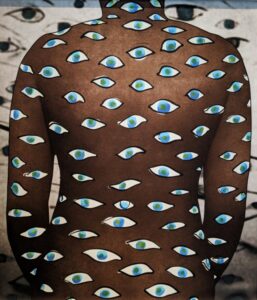
Fig. 6: Maria Magdalena Campos-Pons, The Right Protection, lithograph and paper pulp, 1999, URL: http://africandiasporaart.blogspot.com/2008/05/5292008_29.html (CC license permission)
Thanks to the collage technique of paper pulp on lithograph, skin memory takes on a radically new dimension. The inherent artist’s vision of diversity inveighs against the dogmatic conception of universality that Walter Mignolo qualifies as a ‘fiction of modernity’. Her mulata skin defiantly sports the ability to contain all the spectra of racial identification, though each remote, disconnected eye fails to encompass all the potentialities of meaning. These ‘skin eyes’ are dependent upon the skin that supports them, but they cannot define it as they only occupy a limited portion of this mobile surface. While they remain immobile, Campos-Pons’ skin is prone to moving freely inside this ephemeral panopticon. Praising pluriversality instead of universality, the Cuban-American artist revisits and unsettles the canons of Western visual culture: the brown woman’s body ceases to be a posing object and becomes a looking agent that challenges the spectator’s traditional role[25]. Exits the privilege of the on-looker: the skin artwork now looks back. That such politic/aesthetic idiosyncrasies inform the artistic career of Campos-Pons reflects the inscription of Caribbean female bodies in the larger narrative of transgenerational diasporic connectedness which is often symbolized by the presence of stylized umbilical cords. Presence and absence represent two facets of transience. What matters is the haptic connection with memory transmitters.
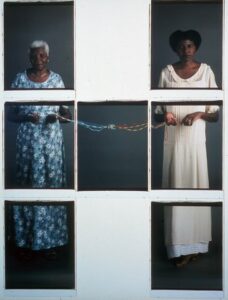
Fig. 7: Maria Magdalena Campos-Pons, Replenishing, 2003 – 9 Polaroid Polacolor Pro, 20 x 24 in. – URL: https:no-miedo.blogspot.com200910maria-magdalena-campos-pons.html, Creative Commons License permission (Photographs courtesy of the Art Appreciation Foundation).
Conclusion
The idea of inscribing the artist’s body on a collective scroll of dermic memory plays a central part in the process of reconfiguration that can preserve and enrich the Caribbean artistic heritage. This stands for a glocal decolonial project proceeding from a re-appropriation of personal, mythological, and historical experiences[26]. The extension of this legacy to Pan-Caribbean communities bears witness to the fact that Foucault’s conception of the body as “a text upon which social reality is inscribed”[27] is not a mere metaphor. Silences are broken, narratives are recombined and histories relocated on local and global levels[28]. All in all, remodeling memory is akin to performing some kind of social sculpture when art and history are called on the stage of memory rehearsal. The presented works constitute tangible evidence that dermic memory is real and can be best connected through trans-American and trans-Caribbean artistic networks, as long as the desire to touch, or apprehend this diasporic art, is fed on, while being freed from colonial grids.
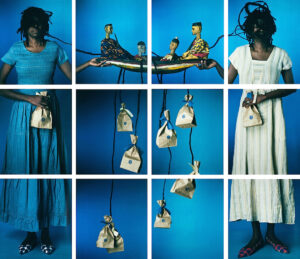
Fig. 8: Maria Magdalena Campos-Pons, De Las Dos Aguas, 2007 – 12 Polaroid Polacolor Pro, 20 x 24 in. –Photograph courtesy of the Harvey B. Grantt Center for African-American Arts.
Since an image is worth a thousand words, we will put a transitory final touch to this study by inviting readers to muse upon the paradigmatic dimension of the boat chronotope which acts as a binding agent between two antagonistic facets of Caribbean identity and memory. As one can notice, the omnipresence of blue colors acts as a binding metaphor: the sea is the transmitter of haptic memory. The above photograph of Campos-Pons on the left shows a campesina (guajira) clothed in a simple blue cloth dress, who holds a brown bag in her right hand while her left hand sustains a migrant boat carrying a family of four. On the other side of the polyptych-like photograph stands a Bostonian counterpart of the same artist who has put on the upper-class code of respectability. The bag is a pack of memory. Wherever it is transported, it carries the weight of the ocean’s trans-personal, inclusive, connectedness thanks to the agency of skin memory.
Bibliography
Brathwaite, Kamau. “Caribbean Man in Space and Time,” Savacou, nos. 11–12, September 1975, p. 1-14.
Benítez-Rojo, Antonio, The Repeating Island. The Caribbean and the Postmodern Perspective. Durham & London: Duke University, Press, 1996.
Campos-Pons, Cuban, Maria Magdalena, Untitled, retrieved from URL: https://library-artstor-org.bu-services.univ-antilles.fr/asset/26796604.
Finley, Cheryl, and Salah M. Hassan, in Diaspora Memory Place: David Hammons, Maria Magdalena Campos-Pons and Pamela Z, New York: Prestel, 2008.
Freiman, Lisa (ed.), María Magdalena Campos-Pons: Everything Is Separated by Water. New Haven, CT: Yale University Press, 2007.
Harris, Wilson. The Ghost of Memory, London: Faber and Faber, 2006.
Hoving, Isabel, “Between Relation and the Bare Facts: The Migratory Imagination and Relationality” in Durrant, S., & Lord, C. M. (2015) Essays in Migratory Aesthetics.
Louise, René. Manifesto of Modern Maroonism. A Philosophy of Aesthetics, Translated into English by Frédéric Lefrançois, Paris: Yehkri, 2018.
Mendieta, Ana. Body Tracks. JSTOR, jstor.org/stable/10.2307/community.11897155. Accessed 4 May 2021.
Mendieta, Ana. Body Tracks. JSTOR, jstor.org/stable/10.2307/community.11913036. Accessed 4 May 2021.
Mendieta, Ana, Body Tracks [Performance], retrieved from https://library-artstor-org.bu-services.univ-antilles.fr/asset/AFURNACEIG_10310797082
Mignolo, Walter, “On Pluriversality”, http://waltermignolo.com/on-pluriversality/. Accessed 14 July 2020.
Paul, Annie, “INTRODUCTION: Caribbean Locales/Global Artworlds.” Small Axe: A Caribbean Journal of Criticism, 2004.
Poupeye, Veerle, Caribbean Art. New York, N.Y.: Thames and Hudson, 1998.
Schildkrout, Enid. “Inscribing the Body.” Annual Review of Anthropology, vol. 33, 2004, p. 319–344. JSTOR, www.jstor.org/stable/25064856. Accessed 20 February 2021.
Shepherd, Verene, and Hilary Beckles, eds. Caribbean Slavery in the Atlantic World. Kingston, Jamaica: Ian Randle, 2000.
Trouillot, M-R., Silencing the Past: Power and the Production of History, Boston: Beacon Press, 1995.
Ultan, Deborah K. “From the Personal to the Transpersonal: Self Reclamation Through Ritual-in-Performance.” Art Documentation: Journal of the Art Libraries Society of North America, vol. 20, no. 2, 2001, pp. 30–36. JSTOR, www.jstor.org/stable/27949150. Accessed 8 December 2021.
Virilio, Paul, “The Aesthetics of Disappearance Part IV”, in The Continental Aesthetics Reader, URL: https://doi.org/10.4324/9781351226387-33. Accessed 29 July 2020.
Walcott, Derek, “The Antilles: Fragments of Epic Memory.” What the Twilight Says: Essays. New York: Farrar, Straus and Giroux, 1999, p. 65-84.
Notes
[1] This is a translation of mangrovie a concept first coined and developed in our upcoming book, Éléments d’esthétique caribéenne.
[2] Derek Walcott, “The Antilles: Fragments of Epic Memory”, in What the Twilight Says: Essays, New York: Farrar, Strass, and Giroux, 1998, p. 69.
[3] Henri Focillon, The Life Forms of Art, New York: Zone Books, 1992, p. 31.
[4] Walcott, ibid.
[5] Focillon, ibid.
[6] Édouard Glissant, Poetics of Relation, translated by Betsy Wing, Ann Arbor: The University of Michigan Press, 2010, p. 94.
[7] Glissant, ibid., p. 137.
[8] Isabel Hoving, “Between Relation and the Bare Facts: The Migratory Imagination and Relationality”, in Sam Durrant & Catherine M. Lord, Essays in Migratory Aesthetics: Cultural Practices Between Migration and Art-making, published in Thamyris, No 17, 2007, p. 180.
[9] Kamau Brathwaite, “Caribbean Man in Space and Time,” Savacou, nos. 11–12 (September 1975), p. 1.
[10] Lesley-Gail Atkinson, “Sacred Landscapes, Imagery, Iconography, and Ideology in Jamaican Rock Art”, in Michele H. Hayward, Lesley-Gail Atkinson, and Michael A. Cinquino (eds.), Rock Art of the Caribbean¸Tuscaloosa: The University of Alabama Press, 2009, p. 43.
[11] Rock- and water-related trails abounding in pre-Columbian history deserve thorough investigation.
[12] Shepherd, Verene, and Hilary Beckles, eds. Caribbean Slavery in the Atlantic World. Kingston, Jamaica: Ian Randle, 2000, p. 25.
[13] Melanie Archer and Mariel Brown, “Introduction”, in A-Z of Caribbean Art, Port of Spain: Robert & Christopher, 2019, p. 3.
[14] This concept substantially differs from that of créolité inasmuch as it gives importance to the possibility of recreating new homes and identities without the prerequisite of ancestral anchoring in local history. Relocation seems more inclusive than hybridity in that light. It would enable, for instance, all kinds of subjects, including the descendants of former slaveholders who have inherited the burden of ‘colonial responsibility’ to emancipate themselves from the ‘mental slavery’. Relocation is the kind of alternative that makes it possible for white creoles like Janine Antoni and Olivia McGilchrist, for instance, to found new artistic ecosystems outside of their native Caribbean islands and claim some legitimacy in the Caribbean ethos without losing identification with their original heritage.
[15] René Louise, “The Great Conceptual Maroonism”, in Manifesto of Modern Maroonism. A Philosophy of Aesthetics. Translation into English by Frédéric Lefrançois. Paris: Yehkri, 2018, p. 64-65.
[16] Clement Greenberg, “Towards a Newer Laocoon”, Collected Essays and Criticism, vol. I, Chicago: University of Chicago Press, 1986, p. 23.
[17] We refer here to the concept of pluriversality designed by Walter Mignolo.
[18] Antonio Benítez-Rojo, “Fernando Ortiz: the Caribbean and postmodernity”, in The Repeating Island, pp. 150-51.
[19] Janine Antoni, “Saddle”, http://www.janineantoni.net/saddle/, accessed 17 January 2021, Saddle, full rawhide , 27x32x79 inches (68.58 x 81.29 x 200.66 cm).
[20] Annie Paul, “Janine Antoni”, in M. Archer & M. Brown, A-Z of Caribbean Art, p. 16.
[21] Patricia Mohammed, “Ana Mendieta”, A-Z of Caribbean Art¸ p. 184.
[22] David Manchioni cited by Jarrod Hayes, “Looking for Roots among the Mangroves: “Errances enracinées” and migratory identities”, The Centennial Review, vol. 42, issue 3, special issue: Locations of Culture: Identity, Home, Theory (Fall 1998), p. 459.
[23] Veerle Poupeye, “The Self and The Other”, in Caribbean Art, New York: Thames and Hudson, 1998, p. 159.
[24] Ultan, Deborah K., “From the Personal to the Transpersonal: Self Reclamation Through Ritual-in-Performance.” Art Documentation: Journal of the Art Libraries Society of North America, vol. 20, issue 2, 2001, p. 32.
[25] Finley, Cheryl, and Salah M. Hassan, Diaspora Memory Place: David Hammons, Maria Magdalena Campos-Pons and Pamela Z. New York: Prestel, 2008, p. 73.
[26] For decolonial aspects of art reception and transmission, see Mignolo, Walter. “On Pluriversality”, http://waltermignolo.com/on-pluriversality/. Accessed 14 July 2020.
[27] Enid Schildkrout, “Inscribing the Body.” Annual Review of Anthropology, vol. 33, 2004, p. 319.
[28] Annie Paul, “INTRODUCTION: Caribbean Locales/Global Artworlds.” Small Axe: A Caribbean Journal of Criticism, 2004. Paul highlights that “Caribbean locales are riven by their own battles for meaningful visual representation” (p. vi).
